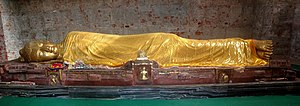Buddhism in the Indian subcontinent
The only two majority-Buddhist nations in the Indian Subcontinent are Sri Lanka and Bhutan. Buddhists are also found in Nepal, India (especially in Maharashtra, Ladakh and Sikkim) and Bangladesh in small minorities. Lord Buddha (Prince Siddhartha Gautam) was born in Lumbini (modern-day Nepal).
Bhutan has the highest Buddhist percentage among the countries of the Indian subcontinent. Though the exact percentage is uncertain, it is over 75%.[1][2] Sri Lanka is 70% Buddhist, where it is the unofficial state religion.[3] Buddhism is also the most important minority religion in Nepal (11% of Nepal's population[4]). India has a Buddhist population of 0.8%, where has been growing rapidly in recent years, due to the conversion of Hindu dalits,[5] while Theravada Buddhism is the third largest religion in Bangladesh with about 0.7% of the total population being Buddhist.[6][7]
The cradle of the Indian civilisation was in the area of the Indus River Valley and the Punjab. The earliest members of the Indus Valley civilization occupied a considerable area of the northwest sometime between 3000 and 1800 B.C.E. Not much is known about the religious ideas and practices of these people. The civilisation was in decline when Indo-Aryan tribes migrated by crossing high mountain passes in the far northwest and settling in the regions nearby Punjab between 1800 and 1500 B.C. The religion of the Indo-Aryans was a regional variant of Indo-European practices, called Vedic. Unlike the peaceful agrarians of the Indus Valley, these people were rough cattle herders. As they acquired political and military power, their religion became classical Hinduism. While it is doubtful whether the office of priest (Brāhmaṇa) was hereditary among the early Indo-Aryans, by the time the Buddha taught, only members of the Brahmin varna could become priests. It was considered a personal honor to worship. Buddhism later branched off from that same stock, which grew and flourished on the religiously diverse plains of the Indus and Ganges.
See also[edit | edit source]
References[edit | edit source]
- ↑ state.gov
- ↑ "kingdomofbhutan.com". Archived from the original on 2013-01-13. Retrieved 2008-03-07.
- ↑ CIA - The World Factbook - Sri Lanka
- ↑ state.gov, The CIA World Factbook
- ↑ Census of India - India at a Glance : Religious Compositions
- ↑ BANGLADESH: COUNTRY PROFILE Archived 2011-07-06 at the Wayback Machine
- ↑ Bangladesh
